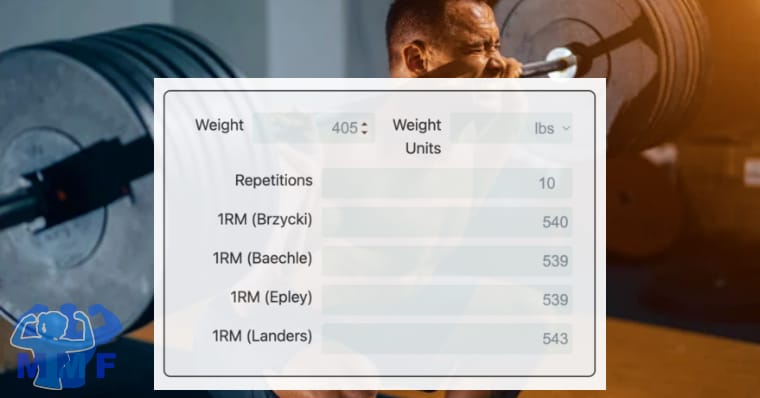Do you want to know your one repetition max (1RM) or one rep max, for bench, deadlift and squats? But you don’t want to get under that heavy bar today. Here is a simple calculator back by science to help you have a good estimate of your 1RM. For you geeks, we will also break down the equations used and their accuracy. Don’t feel bad about being a geek, we are all geeks here.
- 1. Introduction to the Musclemagfitness 1 Rep Max Calculator
- 2. One Rep Max Calculator
- 3. Advantages of Estimating Your 1 Rep Max
- 4. Understanding the Four Different 1RM Calculator Methods (For the Geeks)
- 5. Which Equation is the Best
- 6. Tips for Getting Accurate Results
- 7. How to Perform a 1RM Test
- 8. Wrapping Up: Estimate Your 1 Rep Max With The Musclemagfitness 1RM Calculator
1. Introduction to the Musclemagfitness 1 Rep Max Calculator
The Musclemagfitness 1 Rep Max Calculator is a great way to estimate your 1 Rep Max (1RM). You can use this calculator to track your progress and reach your goals without doing a max lift frequently. We have provided you with Four science backed methods for calculating or estimating your 1RM. Know that these are all only estimates, but they are proven accurate estimates.
2. One Rep Max Calculator
When it comes to weightlifting, knowing your one-rep max (1RM) is important for any serious lifter. But how do you accurately determine your 1RM? The Musclemagfitness 1RM Calculator is a great tool for estimating your 1RM. This chart helps you determine the approximate weight you should use for any lift, based on the number of reps you have completed. It’s a simple but effective way to calculate your 1RM and make sure you’re not over-exerting yourself. To use the chart, simply find your current weight and the number of reps you have completed. Then, look at the chart to see what percentage of your current weight should be used for your next lift. This chart is a great way to make sure you are lifting safely and accurately. With the Musclemagfitness 1RM Calculator, you can easily estimate your 1RM and make sure you’re lifting correctly!
3. Advantages of Estimating Your 1 Rep Max
The Musclemagfitness 1RM Calculator can be a great advantage when it comes to estimating your one rep max with four different methods.
Using the 1RM Calculator can help you determine what weight you should be lifting to get the most out of your training and to ensure you are making progress. Knowing your one rep max can also be beneficial for those looking to lose weight, as it can help you set realistic goals and track your progress.
Additionally, you can use the 1RM Calculator to estimate how much weight you should be lifting for certain exercises. This can help you to stay safe while training, as well as make sure you are lifting a weight that is challenging enough to make progress.
Overall, the Musclemagfitness 1RM Calculator is a great tool for anyone looking to get the most out of their workout. By entering your weight and the number of reps you can do with a certain weight, you can get an accurate estimate of your one rep max. This can help you set realistic goals and make sure you are lifting a weight that is appropriate for your fitness level.
4. Understanding the Four Different 1RM Calculator Methods (For the Geeks)
Calculators are a great way to estimate your one rep max (1RM). But you need to remember that these are only estimates. They are pretty good estimates and there are countless scientific papers written on how to make these estimates better. For instance the velocity you use when conducting your 5 Rep Max can impact the accuracy of your 1 Rep Max estimate. There are many other factors as well. Lets break down the four methods or equations that we provided you in the above calculator.
The Brzycki One Rep Max Calculator Equation
The Brzycki equation is:
1RM = (Weight)÷ (102.78-(2.78 x Reps))
When it comes to fitness and nutrition, accuracy is key. The Brzycki formula is a great tool to help you accurately estimate your one-rep max. With this formula, you can predict your 1RM using either your 3-rep max (3RM) or 8-rep max (8RM). Published in 1993, this formula is fairly accurate, but can be even more accurate if you lift in the same form and range you would use for your 1RM. Therefore, the Brzycki formula and other formulas are most accurate when predicting 1RM from between 3 and 8RM.
The Baechle One Rep Max Calculator Equation
The Baechle equation is:
1RM = Weight x (1 + (0.033 x Reps))
The Baechle formula can be more accurate than the Brzycki equation when it comes to higher reps such as 5RM and above. This formula published in 2000 can be more or less accurate depending on the individual. However, it is still considered a very accurate equation to use when calculating 5RM. It has been reported that Bryzcki, Epley, Lander were not good for estimating squat strength for repetitions to failure, so maybe Baechle can be better for squats. Although all these results are very similar.
The Epley One Rep Max Calculator Equation
The Epley equation is:
1RM = Weight + (0.033 x Reps x Weight)
I also recommend the Epley One Rep Max Calculator Equation as a great way to calculate your maximum weightlifting potential. This equation is based on the number of repetitions you can do with a certain weight, and it can help you take your fitness to the next level. It’s easy to use and provides an accurate estimate of your one rep max. Plus, it’s a great way to track your progress over time and set goals for yourself. With the Epley One Rep Max Calculator Equation, you’ll be able to accurately measure your strength and reach your fitness goals.
The Landers One Rep Max Calculator Equation
The Landers Equation is:
1RM = 100 x Weight÷ (101.3 – (2.67123 * Reps ))
The Lander 1RM equation began as a ‘guess-timated’ chart that was eventually published without the author’s knowledge. When it was derived from his published chart.
The accuracy of the estimates had a range of discrepancies depending on the resistance exercises, such as Bench Press, Deadlift and Squats. The Epley (1985) had the least average error (AE) and greatest relative accuracy throughout resistance workouts studies. However Landers equation was derived from direct measurements of actual 1RMs and can be another useful equation for estimating your 1RM.
5. Which Equation is the Best
When it comes to which equation is best, it is all relative to the inputs of the equation. All of them are relatively close to each other and when you workout program requires you to do a percentage of your 1RM. Use the equation that is most comfortable to you. Professional coaches and trainers take a little more scientific approach, but most of them have been trained to use either a 3RM or 5RM for calculating a 1RM.
A 3RM test and a 5RM test are two tests that coaches use to help athletes get stronger. The 3RM test helps predict how much weight an athlete can lift in one try, and the 5RM test helps predict how much weight an athlete can lift in five tries. Coaches use the Epley equation to predict an athlete’s 1RM when they use the 3RM test, and they use the Brzycki equation to predict an athlete’s 1RM when they use the 5RM test. Research shows that these tests can help coaches know how strong an athlete can be, which can help them become even better.
6. Tips for Getting Accurate Results
Getting accurate results is key when using the Musclemag Fitness 1RM Calculator. Here are some tips to help you get the most accurate results:
- Warm-up: Before you attempt a 3, 5 or 8 rep max, warm-up your muscles and joints to prepare for the exercise. Start with a light 5 to 10 minute cardio session to get your heart rate up and increase blood flow. Do some dynamic stretching and foam rolling to help increase your range of motion and reduce the risk of injury.
- Start Light: Start with a weight that is lighter than your estimated 1 rep max and perform a few sets of the exercise. Gradually increase the weight each set until you reach a weight that is challenging but doable for one rep. This will help you get an idea of how heavy your 1 rep max will be.
- Perfect Form: Make sure you’re using proper form during each exercise. Poor form can lead to an inaccurate estimation of your 1 rep max, so take your time and make sure your form is spot on. Use a Spotter: If possible, use a spotter when attempting a 1 rep max. They can help you lift heavier weights and ensure your safety during the lift.
Follow these tips and use the Musclemag Fitness 1RM Calculator to get an accurate estimate of your 1 rep max!
7. How to Perform a 1RM Test
If you’re looking to increase your strength and reach your fitness goals, eventually you will want to perform a 1RM test. It’s important to know your actual 1RM and the only way to know for sure is to measure of how much weight you can lift in one single repetition. To perform the test, begin by perform a similar warmup as described above in the Tips. After you are warm increase the weight for each set until you reach a weight that you can only lift for one time. Use a spotter or coach to be safe. Make sure to perform the test with proper form and rest between sets to ensure safety.
8. Wrapping Up: Estimate Your 1 Rep Max With The Musclemagfitness 1RM Calculator
Wrapping up, estimating your 1 Rep Max with the Musclemagfitness 1RM Calculator is a great way to track your progress in weightlifting. It can give you a good estimate of how much weight you can lift, and also provide some guidance on how to increase your maximum weight. Additionally, it is a great tool to use to set realistic goals for yourself and keep you motivated. The calculator is easy to use, with the help of this calculator, you can monitor your progress and make sure that you are reaching your goals.
References: 1. Muscle Strength and Power Assessment Using 1 Repetition Maximum Testing 2. Strength Training: Progression and Exercise Prescription 3. 1 Repetition Maximum Test for Estimating Maximal Muscular Strength 4. The One-Repetition Maximum: A Review of Reliability, Validity and Methodology 5. Accuracy of Predicting One-Repetition Maximum from Submaximal Velocity in The Barbell Back Squat and Bench Press 6. Accuracy of Seven Equations for Predicting 1-RM Performance of Apparently Healthy, Sedentary Older Adults


